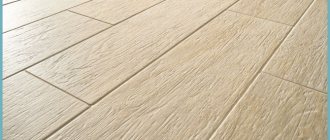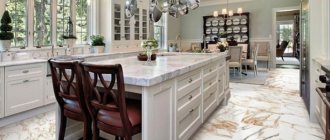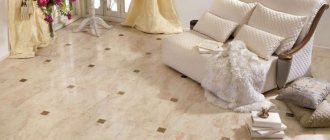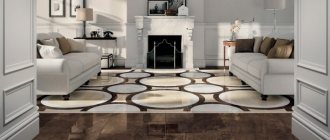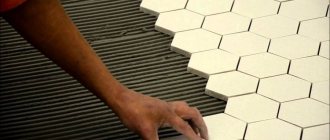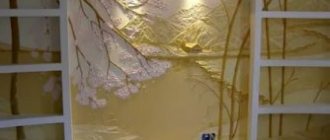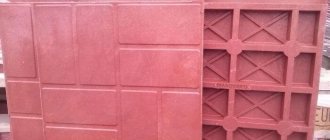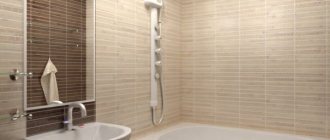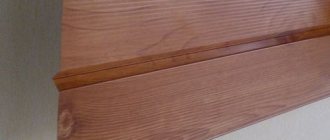The variety of floor tile designs is amazing. There is a place in it for both traditional options and new innovative finds that allow you to implement interesting design solutions. As a final example of know-how, wood-look ceramic tiles. It allows you to visually imitate the surface of a natural material, while retaining all the properties of durable tiles.
How to lay porcelain floor tiles under wood: methods and options
Today, wood building materials are very popular due to the fact that they have a number of benefits for humans. However, wood has a shorter service life than other facing materials. To solve this problem, many owners began to consider other materials that would have no worse technical characteristics, but could visually imitate wood flooring.
This became possible after giving a certain coating to porcelain stoneware. Tiles made from this material are durable, reliable and their service life is much longer than that of wood. The article will discuss how to install such a coating, starting from the preparatory stage and ending with the installation itself.
Purchase of tools and material for cladding
Even if money is limited, you cannot immediately select tiles at the lowest cost, because in the case of this material: the higher the price, the higher the quality. It is best to present the choice to a specialist, since an inexperienced owner may not notice flaws on the surface of the product. During the installation process, it is, of course, possible to organize everything in such a way as to hide imperfections, but this requires some skill.
If the selection is done on your own, then before purchasing you need to pay your attention to the following invisible points:
It is best to buy adhesive composition for installation based on the average cost category. The cheapest compounds have a low degree of adhesion and take too long to dry, which is simply not acceptable. It is not necessary to spend money on very expensive mixtures based on saving money, since you can always choose a more inexpensive option if you do not base your choice only on expensive branded compositions.
The tools for laying porcelain tiles are as simple as possible, and you can purchase the necessary tools, if they are not in the house, at the same hardware store where the materials were purchased.
An employee must have the following tools in his own arsenal:
Laying out wood floor tiles
When choosing tiles for the floor in an apartment, you want something very natural, practical and durable. In this case, porcelain stoneware or wood-look ceramic tiles are ideal; these materials fit the request, except that the imitation of natural wood and the practicality of a ceramic floor will not create the same comfort for our feet as real wood, but there are solutions for this , for example, the same warm electric floor under tiles or water floors, if we are talking about a country house or cottage with its own boiler room.
But judging by the title of the article and the photos posted, it is obvious that we will talk about the layout of such tiles (simulating wood). Please pay attention, we will talk about classic options, without Christmas trees and various kinds of tile art.
You can often see that for such tiles they choose a fairly classic layout, for example, in a checkerboard pattern; in my opinion, this is far from simulating a wood floor. As a rule, such tiles replicate laminate, parquet boards, solid wood, parquet, and for this reason, in order to recreate a good imitation, it would be correct to lay it in the same way as you would lay parquet or solid wood, depending on the size of the tile itself.
Now I’ll go back directly to laying out wood-look tiles. There is a desire to give some advice and recommendations, both for master tilers who encountered this for the first time, and for everyone who made a similar request in the search) In no case am I going to teach and confuse / since choosing a tile is already difficult, and if you take into account Everything is getting even more complicated!/.
First recommendation (advice for laying wood-look tiles - classic options).
There is no need to rush into purchasing tiles. After choosing a tile, before making a purchase, I recommend that you make a layout “on paper”, which you can do yourself using standard programs that are on every computer. Personally, I used Paint, it turned out clear and quite visual. If you understand that this tile suits you in appearance, texture, pattern /print/ of wood, it can have from three to eight or more patterns.
If the number of prints on the printer is small, avoid choosing tiles with knots, especially if the tile is small, otherwise there will be too many "spots" in the form of knots.
In my example, the layout of wood-effect tiles Estima Brigantina 120X30
Layout options that I was able to select
Option No. 1
Option No. 2
Option #3
Option No. 4
Option number 5 - which we settled on
Second recommendation.
The tiles have been purchased and delivered, and this layout should be repeated locally. Understand what width of seam is suitable for your tiles. In some cases it is needed minimally, but in other cases a seam of 2-3 mm will look good. Be sure to determine the place from where it will be laid in order to understand how and where it will end on all sides. In rare cases, it is possible to avoid unsightly trimming along the edge of the wall by using just one millimeter of seam)
Several photos to illustrate the layout of wood-look tiles
If you are reading the article, then you are seriously “confused” by this
and it is important for you to know all the details that are not visible at first glance. Especially if the entire floor in the apartment is being laid, then of course it is advisable to look at everything!
The main thing I wanted to say is written above. Laying out wood-look tiles, any layout, is a very important part of tiling work. This should be done by a designer, but somehow I heard “. Why overpay!? “I hope the short material I have prepared on this topic will bring you benefit, understanding and savings.
If you need individual advice. You can use the “ask a question” form and I will definitely answer you in a short time.
Laying methods
Correctly chosen tile installation allows you to demonstrate all the beauty of the texture of the described material. The appearance of the renovated room largely depends on this moment, so it makes sense to talk about this in more detail.
Deck laying
Tiles or porcelain tiles laid peddled look quite creative. It is chosen when it is necessary to visually elongate a room, when you want to experiment with the installation process on your own for the first time, when it is necessary to minimize the amount of waste that invariably appears during the installation of a modular floor covering.
When laying on deck, the tiles are laid in rows with a minimum shift (one fifth or sixth of the length of the module). If it is possible to achieve even rows of seams between the dies, the effect of the integrity of the coating is completely preserved. In this case, the tree pattern is completely preserved. The deck method can be used if wood-look tiles of different sizes are purchased for the flooring. In this case, the dies are laid on the floor in a chaotic manner.
You can use deck laying not only by laying tiles strictly straight, but also diagonally. This method of assembling the flooring allows you to visually make a narrow room more spacious. An interesting pattern can be obtained by alternating modules of different colors and different textures. Another installation method is to lay the dies in pairs. It allows you to get a more noticeable large pattern. The deck assembly method allows you to lay the dies in radials from the center or from any other point in the room.
There are many advantages to deck laying. This is, first of all, ease of installation, and the process of assembling the floor covering takes a minimum of time. There is only one drawback - the simplicity of decoration. The assembly methods described above allow us to emphasize the beauty of the texture, but the overall design of the flooring looks very traditional.
Parquet assembly
When decorating classic interiors, parquet flooring is often used. With it, the tiles are laid out according to the principle of the arrangement of the paws of spruce trees (the tiles are placed in relation to each other at an angle of 90 degrees, in relation to the walls - at an angle of 45 degrees). Floor tiles can be laid in this way either diagonally or straight. Laying modules diagonally is the most difficult. You will first have to make clear markings on the floor. In order for the result to turn out beautiful, you have to try.
Tiles laid on the floor according to the herringbone pattern will look like natural parquet. Only a qualified craftsman can distinguish which floor covering in this case lies in front of us. Sometimes, to create a special accent for installation, tiles of different shades are used. This choice allows you to make a special floor covering that invariably attracts the eye and distracts attention from other shortcomings of the room.
If you want to create a particularly decorative coating, you need to place the dies in pairs next to each other, then you will get a “double herringbone”. If you arrange the dies in three pieces, you will be able to create a “French herringbone”.
The described method of assembling flooring has undeniable advantages over other options. Let's indicate the main ones.
- Cost-effective – minimal amount of waste is generated during installation.
- Versatility. “Herringbone” fits perfectly not only into classic interiors, but also into the concept of modern styles.
- Coating stability. The described arrangement of the dies allows you to evenly redistribute the load over the entire floor covering. This reduces the risk of deformation of individual elements.
A game of checkers and chess
Another simple technique that is often used when laying wood-look tiles is tiles laid in a checkerboard pattern. This method allows you to implement solutions of different color combinations. If, for example, you lay tiles of contrasting colors alternately lengthwise, you will get a floor covering that visually increases the length of the room. Modules laid across the wood grain look the most beautiful.
You can direct the checkerboard in different ways: vertically, horizontally and diagonally. Not only alternating colors is allowed, but also textures. The most impressive looking installation option is one in which the checkerboard pattern occupies only the central area of the floor, with deck masonry on the sides. There are quite a few options, the choice should be made taking into account the overall design of the entire room.
Wooden wicker
Laying tiles under wood in the form of a braid is the most difficult. It will not be possible to carry out floor covering yourself without certain professional skills and knowledge. And all because you need to arrange the tiles in such a way that the fibers of the pattern across the entire surface of the floor covering are oriented in one direction. This is the only way to achieve the effect of forming a bast basket. It is he who looks especially unusual and attractive.
Note! Wooden wicker can be assembled in a variety of ways, the most difficult being combining three or four color tones of the same wood tile. The master, by folding them, achieves the creation of a three-dimensional drawing. It looks quite beautiful and respectable.
Parquet wicker is an artistic form of laying wood-look tiles. It belongs to a type of geometric styling. To create it, wood-like tiles of two, three or four shades are used.
They can be located perpendicular to each other, or interspersed with inserts in the form of small squares. By varying the size of the squares or the dimensions of the rectangular tiles, you can create different braided patterns. The choice of weaving method largely depends on the size of the room, the materials used and the financial capabilities of the owners.
Experts distinguish three types of braiding:
- Homogeneous. It is formed by using tiles of the same color and pattern. The braided effect in this case is achieved by playing with the texture of the wood pattern on the tile. A homogeneous braid with inserts of squares assembled from triangles looks especially interesting.
- A wicker made from tiles imitating two types of wood. In this case, the tile tiles imitate one type of wood, and the squares are selected in contrast to the main tiles. This combination creates a three-dimensional effect.
- A wicker made from tiles imitating three types of wood. This layout option is the most expensive, and all because one color of tile will have to be cut in half and framed with them the main rectangles along its longest sides. As a rule, such braiding is laid diagonally, in this case the amount of waste increases significantly. And this increases the cost of the final floor covering.
Using wood-effect tiles, you can try to assemble a more complex artistic covering, recreating the effect of the so-called “Sheremetyevo laying”. In this case, you will have to make rhombuses from rectangles and lay them at an angle of 45 degrees to each other. The entire pattern is made up of fragments, each fragment is a hexagon with equal sides, made up of three pairs of dies.
Possible solutions and what different craftsmen do when laying porcelain stoneware under wood.
The first option is to level the joints between the tiles using SVP.
One small detail - Uncle (USA, Boston, North Shore) additionally applies adhesive to the tiles when using SVP. Although, his glue “MAPEI ULTRAFLEX” is highly plastic (“ S2”) , for deformable bases and large format tiles on facades, balconies, terraces:
The most popular glue in the USA.
This is about the eternal debate - is it necessary to apply glue twice to porcelain tiles when using SVP. The specialization of this master’s work is narrow: ceramic tiles in bathrooms and heated floors. That is, there is a lot of experience in performing similar operations. If he came to such technology, then there were reasons for it.
Checking the condition of the bearing surface
In the case of laying porcelain tiles on a “dirty” floor or any other base, the main requirements should be considered:
If the imperfections of such a surface are insignificant, then a mixture of glue used to hold the tiles can help remove them. In case the situation is worse, experts advise using a screed. It is created by applying a sand-cement mortar with a thickness of 2 centimeters, which will greatly increase the strength characteristics of the coating.
Room measurement
Initial measurements of the room before laying ceramic granite flooring
under
a tree
, should not be limited to just measuring the area of the surface to be covered. During the construction work of the building, the slightest distortion of the angles of the walls is quite possible, which means that the opposite floors may not be parallel.
This difference can be a couple of centimeters, which means that the tiles on one of the walls will have to be cut in a wedge shape. The elegance of such a covering is slightly compromised, and in order to avoid places that cannot be shown to guests or in the photo, it is best to insert them near the walls where the furniture will be located. It is important to avoid placing such cut pieces near doorways.
If it is not possible to close such a place, then you need to achieve the greatest symmetry. Since the laying begins specifically from the center of the floor, when gluing back and forth, a professional must obtain equal empty areas near two opposite walls and insert identical wedges of tiles into them. Due to the need for such inserts, tiles should be purchased in quantities 5-10 percent larger than what was calculated when measuring the area of the room.
Also a fundamental point in this matter is the preparation of a tile laying scheme. Today, a large number of drawings are known according to which ceramic granite can be installed. This issue has an impact on the speed and difficulty of installation work. The naturally selected scheme should correspond to the theme of the room design. The owner has the right to conduct some experiments and lay out tiles on the floor without gluing in several versions in order to understand which one will look the most beautiful.
Cleaning surfaces from dust
Naturally, a “dirty” floor will not sparkle, but it is also unacceptable for there to be dust and dirt on it before installation. To do this, you need to sweep and, perhaps, easily wipe the base for laying one row. Subsequently, this impact should be done as the installation progresses, and not throughout the entire room at once.
Immediately after this, you can begin preparing the glue composition. Detailed instructions will always be found on the packaging of this mixture. There is no need to immediately prepare a significant amount of glue, since it can be used within an hour, and then it will have to be diluted with water, which will reduce its characteristics. Naturally, it would be correct to apply a new composition a couple of times during installation.
A selection of photographs with design ideas
Our photo selection will give some idea of the possible design options. But you shouldn’t take them as dogma, these are just ideas that need to be used creatively.
Thanks to the ingenuity of floor tile manufacturers, you can now admire the exquisite texture of wood in any room, regardless of its purpose. This opportunity will primarily be of interest to connoisseurs of ecological style who are planning renovations in the kitchen or bathroom.
Humidity and temperature changes do not allow the use of laminate and natural wood there, but modern tiles will create the complete illusion of natural material, and will not “be capricious” in a humid environment.
Country-style kitchen tiles will look organic and very homely. Aged surfaces, forging, and appropriate textiles will create a special mood. The combination with glossy surfaces of ultra-fashionable cabinet furniture may also be interesting.
In addition, wood-effect ceramic tiles can be used in more original and unusual ways: they are often used for cladding kitchen backsplashes, finishing panels and niches. Such non-standard techniques allow you to make the interior original and individual, unlike others.
Porcelain tiles and ceramic tiles with a wood-like texture will be a non-standard solution for the floor in a hallway or spacious hall. They will perfectly withstand the loads associated with the high traffic of these premises, and from the threshold they will tell about the good taste of the owners.
Tiles in the living room are a rather unusual, fresh solution that will bring additional bonuses: you can save on buying expensive parquet and get an equally impressive floor covering in return. In addition, if the installation technology is strictly followed, it will last for many years without requiring repairs.
How to lay tiles on a bathroom floor
Ceramic parquet flooring is particularly difficult to install. The variety of shapes makes it possible to lay out almost any pattern typical of solid wood or parquet floors.
Another feature of wood-look tiles is that they are laid end-to-end, without seams. In those rare cases when this is not possible, it is recommended to take the thinnest crosses and select the grout exclusively to match.
The completely smooth surface without seams typical of ceramics allows you to lay wood-look tiles in hallways, living rooms and even bedrooms. The only thing is that the rooms will require installation of heated floors.
It will be quite difficult to lay tiles “in a pattern” on your own without certain skills. An error of a few millimeters or in the shade of the next plate can play a cruel joke - instead of an ideal floor, you will get a low-quality semi-finished product.
Grouting joints
The very next day you can remove all the crosses from the seams. The product used for grouting can be either the same tone as the tile or contrast with it. Detailed instructions for preparing and applying grout are available on the product packaging.
There is no need to worry about the appearance of the coating, since any contamination can be removed within a day after application. As a result, when the wood-effect porcelain floor tiles have been laid and cleaned, they are completely ready for use and can be finally washed and the skirting boards secured (for more details: “Porcelain stoneware skirting boards - types and advantages”).
Bottom line
Having completed all the above steps, you can perform the installation yourself or, at least, monitor the progress of the work performed by a specialist. To ensure the quality of the resulting coating, you can tap the entire surface. If the sound from the impact is loud, then this indicates the presence of a void under the tile. Those who have laid tiles less than 1 centimeter thick should be wary, as they will definitely crack under sufficient load. Accordingly, it is worth avoiding heavy physical impact on this area of the coating.
Rich assortment
Any ceramics that helps imitate wood looks great in any classic interior. It is often used to implement the concepts of rustic style and extravagant ethnic style.
On sale today you can find floor tiles of any color. The color palette is varied. The collections include almost white tiles (bleached wood), gray wood-like tiles look great in the interior, and almost black tiles (wenge-colored wood). Other shades of wood are also available to buyers. How to choose the right option in all this variety? The answer to this question must be sought in the characteristics of the room being decorated.
- For example, tiles of dark tones from the collection of stained oak, exotic zebrawood, and cherry can decorate floors in spacious rooms and large rooms.
- Tiles that can imitate the cut of birch or pine, oak or teak are most often used to decorate the floors of small rooms. The light texture visually expands the boundaries of space and allows you to fill the room with air.
- Tile imitating the surface of walnut or maple, ash or Karelian birch is traditionally chosen for bathroom flooring.
- Rich colors of pear or alder, as well as mahogany, are most suitable for kitchens.
Note! In the collections of European manufacturers you can often see tiles with uneven coloring. With its help, an aged floor surface is formed. A similar effect is created using the brushing method (artificial aging). This material is good for the Provence style. Placed on the floor, it attracts attention with its uneven coloring. If you manage to combine the colors of the tiles with the colors of textiles or furniture filling, you will get a homely, warm and cozy interior.
How to lay tiles on a wooden floor?
The work is carried out on logs - these are wooden cross members, which are characterized by a large cross-section. They serve as supports for the whole object or some structural elements. Wooden flooring is also in most cases mounted on top of the joists. If tiling is to be done, a rough base must be prepared. The condition of the floor may vary:
- The floorboards are completely dismantled due to their poor condition: extensive rot, cracks, and rot have appeared. If the flooring is damaged, you will need to remove all or only some of the covering elements. Having removed them, check the condition of the lags. If they are not damaged, installation work can continue. In the case where the logs are also exposed to negative factors, these elements are replaced or restoration is carried out: the crossbars are only partially replaced and treated with special compounds.
- Sometimes logs are covered with cheaper materials - chipboard, OSB, plywood. The next step is laying the cladding.
- If the joists are seen to be in good condition, the decking base is left in its original condition, but the floor structure is checked for damage. In this case, the tree has just been laid, or the base was installed not so long ago and has not had time to wear out. In both cases, the flooring is not replaced, but additional leveling may be required.
For each option, a different cladding technology is selected, since the process of preparing the base is different.
First method: dry leveling
To lay the tiles, prepare the base. To prevent the cladding from deforming during operation, its installation is carried out on slabs/sheets used to level the floor on the joists. Materials that can be used for this purpose:
- drywall, characterized by moisture resistance;
- gypsum fiber sheet;
- cement bonded particle boards;
- moisture-resistant plywood.
All these varieties are laid in 1 or 2 layers. The slabs can be fastened with self-tapping screws, and the installation step of the fastening elements should be small, otherwise the coating will “play” when walking. To make the rough base more durable, it is recommended to process the end sections using a special glue that is designed to work with the material.
If a wooden floor is installed in a bathroom, kitchen or other room where humidity regularly rises and there is a high probability of contact with water, the joints of the slabs are covered with membrane-type polymer waterproofing. It is important to protect the corner areas where the wall meets the floor. Here the waterproofing is applied with a slight overlap on the wall (up to 5 cm).
The preparation of the wooden floor for tiles is carried out before installing the cladding. For this purpose, a primer composition is used. They process the resulting coating. At the next stage, the painting mesh is laid. It is recommended to repeat the priming procedure on top. This measure will improve the adhesion of the adhesive and the base. An important point is the need to lay the subfloor slabs so that the joint joint falls in the middle of the wooden crossbar (joist).
Cement bonded particle boards should be laid on top of the plasterboard/plywood. They are the main structural element of a floor installed using dry leveling technology. This is due to the sufficient strength of such products and their durability. During the installation of the base, its surface is constantly checked for quality, for which a level is used. You cannot lay tiles on uneven floors.
Advantages of the dry leveling method:
- you can add a layer of insulation to the subfloor structure;
- due to the low weight of the floor, the level of load on the joists is reduced;
- high installation speed, because in this case there is no need to work with cement screed.
So that the process does not have to be interrupted, the necessary materials are first calculated: the number of slabs, fastening elements, and cladding is determined. This method also has disadvantages. For example, installing a multi-layer floor structure, which is also raised on joists, will help reduce the height of the ceilings. This means that dry leveling technology is not suitable for all objects.
Wood effect floor tiles - cost
The cost of ceramic parquet is an order of magnitude lower than regular parquet. Especially if you compare rare types of wood and their ceramic counterpart. Buying wood-look tiles will help you significantly reduce your renovation budget.
The cost of installing ceramic and wood flooring is comparable. But in terms of maintenance, tiles will cost you much less than parquet or natural boards. Sanding, varnishing, refinishing, painting - all these words will cease to have meaning for you if wood imitation tiles are laid on your floor. Even if one tile is damaged for some reason, for example, you drop something heavy on it, replacing it will be much cheaper than a parquet tile.
Applying the adhesive mixture
The composition must be applied with a comb, and if it is necessary to remove surface defects, they can always be filled with glue. You can control the inclined angle and placement of the tiles using a bubble level or a primitive strip of wood. The device must be rotated from side to side to prevent the formation of a slope in any direction.
You also need to control the placement of tiles at the seams between them if the classic installation method is used. There cannot be an adhesive layer in the seams, as this will not leave room for the required amount of grout. The grouting agent must occupy at least 2 millimeters in the seam.
Finishing the wall base
It also makes sense to tile the wooden bases of the walls only when an additional plywood or plasterboard layer has been created. Otherwise, the tile simply will not stay on the wall.
The elements are also laid on the primed surface of the sheets. Moreover, installation begins from the second row. They move forward, capturing small areas. It is recommended to increase the layer of adhesive composition by applying it to walls and ceramics. This will give the cladding additional space to move. Regulatory crosses are placed on the seams. The average seam size is 3 mm. It is not allowed to lay tiles in a seamless manner in a wooden house. Since changing the volume of the base may lead to the overlapping of elements.
Lastly, they begin laying out the first row of tiles, since in most cases it represents a row of cut fragments. The cracks and joints are sealed with silicone sealant, the seam gaps are covered with grout after the glue has dried.
It is possible to tile wooden surfaces in a bathroom or kitchen in a wooden house, especially when all the intricacies of the installation and construction process in a given situation are known. Happy renovation!
Beginning of work
You need to start gluing the tiles from any of the walls of the room. From the very beginning, a number of solid tiles are fixed, and the uneven parts are left empty.
If, for example, a seamless installation option is used, you have to make sure that the edges on the sides of the tile are clean and free of any particles. Also, the product must be wiped clean before being fixed to the adhesive base. In this case, the tile falls vertically onto the base and it is not recommended to move it, as this will lead to glue getting into the space between the edges.
